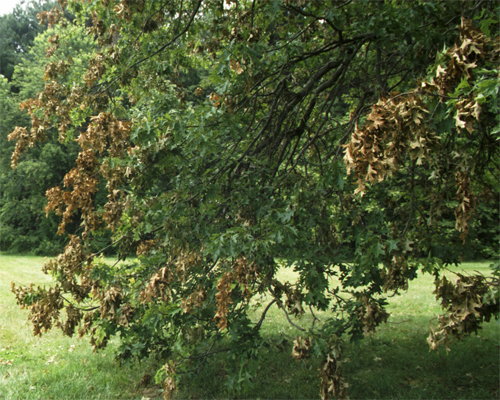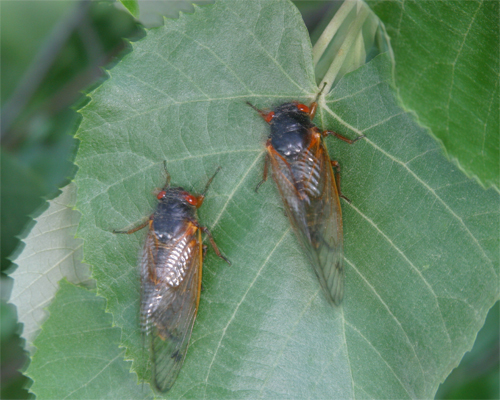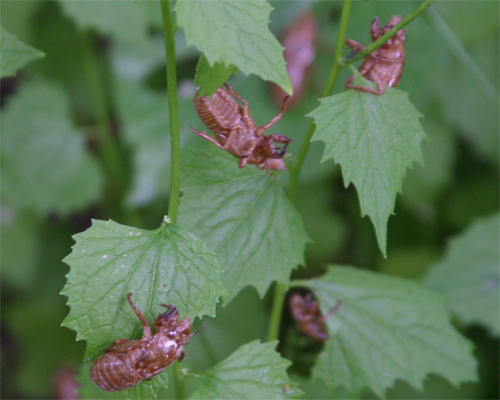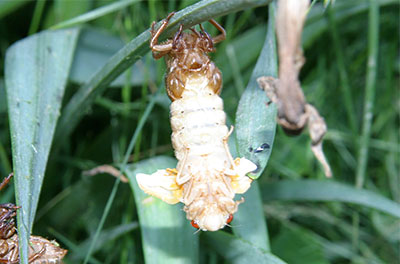


Fact Sheet FS220
No other insect causes as much curiosity and wonder as periodical cicadas do. Their sudden appearance in late May or early June is dramatic and usually noisy as the males produce a seemingly endless whirring sound. Usually the "chorus" begins shortly after day-break and continues uninterrupted until evening. In areas of heavy emergence, the noise created can be deafening. The insects mate within 1 week and females begin to deposit their eggs about 7 to 10 days after emergence.
After 6 or 7 weeks, eggs deposited in twigs by female cicadas hatch and the tiny young (nymphs) drop to the ground, dig into the soil, and remain there for the next 17 years. Fortunately, cicadas are not especially destructive. They do not feed to any extent as adults. There is no stripping of foliage as with gypsy moth caterpillars. Injury to trees is caused by female cicadas as they use their ovipositor to insert their eggs in twigs. This process causes the twigs to die from the egg-laying site to the branch tip (perhaps 1 foot or so, Figure 1). Thus, leaves turn brown and the branch tip generally breaks off or "flags" at the egg-laying site. In most instances, this loss of branch tips amounts to "natural pruning."
Description and Lifecycle
The adult cicada is about 1 5/8 inches long. Most of the body is black. Its legs and eyes are reddish. Some of the veins in the nearly transparent wings are orange (Figure 2).
Using the blades of a curved, saw-like, egg- laying apparatus on the end of the abdomen, the female cicada punctures the bark of a twig and makes a pocket in the wood. In the pocket she lays 24 to 28 eggs in two rows. She then moves forward, cuts another pocket, and lays more eggs. This process continues until 5 to 20 pockets have been made in the twig. The pockets are placed close together in a straight row. Sometimes these rows form a continuous slit 2 or 3 inches long. Moving from one twig to another, a total of 400 to 600 eggs are deposited. Seventy to 80 species of trees, shrubs, and herbaceous plants are commonly used by cicadas for egg laying. Those preferred by females include oak, hickory, apple, peach, and grape.
When the eggs hatch, the nymphs fall from the plants and enter the soil where they burrow 18 to 24 inches into the ground in wooded or forest areas. In apple orchards they feed 2 to 18 inches below the soil line. As many as 104 cicada nymphs have been found in one square foot of soil under apple trees. Severe decline of apple trees sometimes occurs in older orchards where high populations of cicadas exist.
The nymphs are fully grown after the seventh or eighth year, but continue to feed and develop until the spring of the 17th year. Several weeks before emerging from the ground, the nymphs start to burrow upward. When they tunnel to about 1 inch beneath the surface, they stop and await the proper time to continue.
Under certain conditions, cicada nymphs construct small cones or "chimneys" of earth above the soil surface several weeks before emerging. The cones may protrude two or three inches above the ground and may be one or two inches in diameter. If the nymphs do not construct a cone, it is common to see the hole they make a few weeks before emergence. This hole is about 1/2-inch in diameter and extends well below the surface of the soil. In some areas, especially under trees, these holes may be numerous.
When the proper night arrives, the nymphs leave the ground in vast numbers and walk to upright objects. A tree is an ideal goal. If a tree is not within range, a bush, blade of grass, post, utility pole, or a similar object will do (Figure 3). Each nymph secures a firm hold on the object, splits its nymphal skin along the middle of its back and works itself out (Figure 4). The transformation is completed in one hour or less. The newly emerged adult is soft and white. As the skin hardens it also darkens. In a few hours the cicada is fully mature and after mating the cycle is repeated.

Fig. 4: Newly emerged adult cicada.
Interesting Facts
For convenience of reference, emerging broods have been designated by Roman numerals. Numerals I through XVII are assigned to the 17-year broods and species. They are assigned as though a brood were to emerge each consecutive year. The system began with the 1893 brood (Brood I). The 1894 brood was Brood II, and so on. Thirteen-year species, found in the Southern states, are numbered XVIII through XXX. The habitats for all species overlap and there may be some gaps in both 17 and 13-year broods.
Four of the 17 possible 17-year broods are referred to as "doubtful," "unimportant," and "almost extinct." Generally, brood survival depends on habitat survival. Forests, parks, estates, and areas undisturbed by construction (or soil and/or tree removal) usually retain their periodical cicada populations. However, cicada population density may vary from one emergence to another. Brood II and Brood X are the largest broods found in New Jersey. Their occurrence is listed in Table 1. Affected areas may be determined by reviewing newspaper records in local libraries or by visiting with people who were living in these areas at the time.
Many interesting superstitions have evolved due to the usual spectacular emergence of periodical cicadas. Native Americans perceived the cicada's periodical appearance as signifying something evil. Early American colonists had never seen periodical cicadas so when cicadas appeared suddenly by the millions, they thought a "locust plague" had been visited upon them and thus the name "17-Year Locusts."
Management
Insecticide applications are usually not effective or warranted because new cicadas emerge every day and they can fly as far as 1/2 mile. The exception to this would be applications in nurseries to protect susceptible plants. In residential areas where cicadas have been previously abundant, postpone planting young shrubs and trees from spring until fall. Small trees and shrubs may be protected by covering them with an open-weave cloth. The cloth should be put in place as cicadas appear and should remain for about five weeks.
| BROOD II | BROOD X |
|---|---|
| 2013 | 2021 |
| 2030 | 2038 |
| 2047 | 2055 |
| 2064 | 2072 |
Photo left: Damage caused to twigs caused by the egglaying behavior of the periodical cicada.
Photo center: Adult periodical cicadas.
Photo right: Nymphal cicadas just after emergence from the ground.
Photo credits: George Hamilton
March 2021
Copyright © 2024 Rutgers, The State University of New Jersey. All rights reserved.
For more information: njaes.rutgers.edu.
Cooperating Agencies: Rutgers, The State University of New Jersey, U.S. Department of Agriculture, and Boards of County Commissioners. Rutgers Cooperative Extension, a unit of the Rutgers New Jersey Agricultural Experiment Station, is an equal opportunity program provider and employer.

